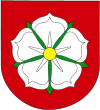Zagórów
Zagórów [zaˈɡuruf] (German: Hinterberg) is a town in Słupca County, Greater Poland Voivodeship, Poland, with 2,908 inhabitants (2004).
Zagórów | |
|---|---|
Baroque Saints Peter and Paul church with the gate | |
 Flag  Coat of arms | |
 Zagórów | |
| Coordinates: 52°9′56″N 17°53′30″E | |
| Country | |
| Voivodeship | Greater Poland |
| County | Słupca |
| Gmina | Zagórów |
| First mentioned | 1240 |
| Town rights | 1407/1445 |
| Area | |
| • Total | 3.44 km2 (1.33 sq mi) |
| Population (2006) | |
| • Total | 2,932 |
| • Density | 850/km2 (2,200/sq mi) |
| Time zone | UTC+1 (CET) |
| • Summer (DST) | UTC+2 (CEST) |
| Postal code | 62-410 |
| Website | http://www.zagorow.pl |
History
The town's name is of Old Polish origin and comes from the word zagór.[1] The oldest known mention of the settlement comes from a document from 1240.[1] Zagórów received town rights from King Władysław II Jagiełło in 1407, however, these rights were implemented only in 1445.[1] Administratively it was part of the Kalisz Voivodeship of the Greater Poland Province of the Polish Crown. The town suffered as a result of the 17th-century Polish–Swedish wars.[1]
It was annexed by Prussia during the Second Partition of Poland in 1793. Regained by the Poles in 1807, as part of the short-lived Duchy of Warsaw, it passed to the Russian Partition of Poland in 1815.[1] Polish insurgents were active in the area during the January Uprising in 1863, and a battle was fought in the nearby village of Myszaków.[1] As part of Anti-Polish repressions after the fallen uprising, the tsarist administration stripped Zagórów of its town rights in 1869.[1] Town rights were restored in 1919, after Poland regained independence.[1] In the interbellum the local economy revived.[1]
During the German occupation of Poland (World War II), on November 21-22, 1939, 10 Polish inhabitants of Zagórów, former participants of the Polish Greater Poland uprising (1918–19), were murdered by the Germans in the forest in the nearby village of Grabina.[2] The Germans expelled some Poles to the so-called General Government.
In 1940, the Germans forced Zagórów's 600 Jews into a ghetto ghetto and then resettled hundreds of Jews from other localities into the ghetto, without money, jobs, or places to live. Over 2000 Jews were now in the ghetto, 10 to 15 people per room. In 1941, some were sent to a forced labor camp in the salt mines near Inowroclaw. In late September 1941, all the Jews still in the ghetto were taken to the Kazimierz Biskupi Forst where they were murdered. Eyewitness testimonies document the horrific day where Germans were experimenting with mass killing methods.[3] Only a few Zagórów Jews survived the war. [4]
References
- "Położenie i historia". Urząd Miejski Zagórów (in Polish). Retrieved 13 April 2020.
- Maria Wardzyńska, Był rok 1939. Operacja niemieckiej policji bezpieczeństwa w Polsce. Intelligenzaktion, IPN, Warszawa, 2009, p. 210 (in Polish)
- "Transports to Extinction: Zagorow to Kazimierz Biskupi". Transports to Extinction. Yad Vashem. Missing or empty
|url=(help);|access-date=requires|url=(help) https://deportation.yadvashem.org/index.html?language=en&itemId=12834211&ind=7 - Megargee, Geoffrey (2012). Encyclopedia of Camps and Ghettos. Bloomington, Indiana: University of Indiana Press. p. Volume II 120-121. ISBN 978-0-253-35599-7.